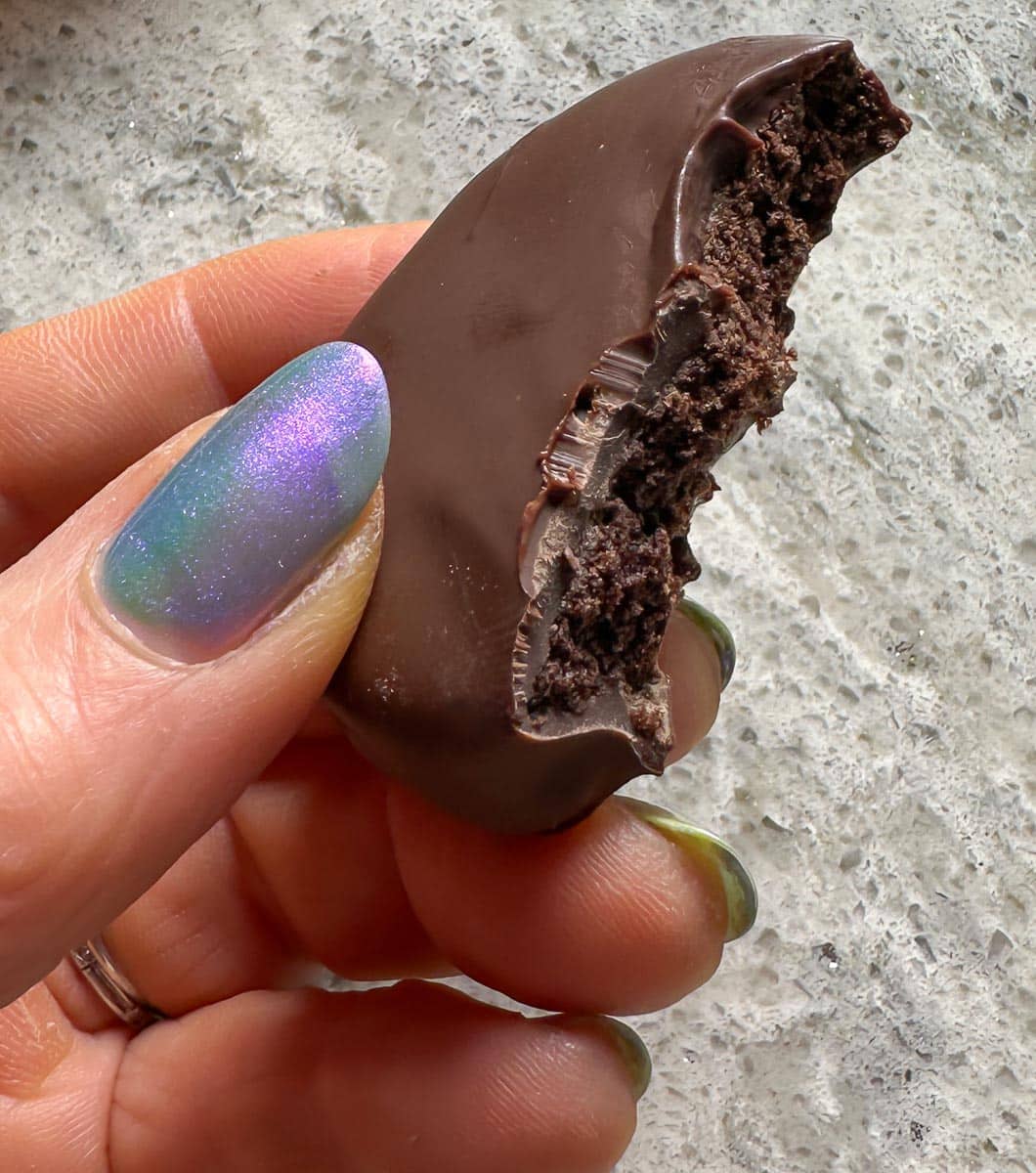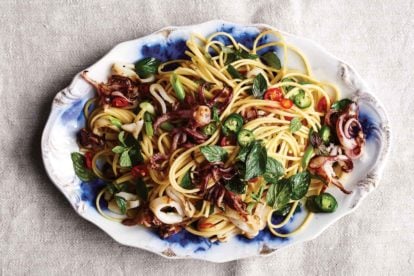Our version of Low FODMAP Chocolate Thin Mint Cookies is a Girl Scout copycat, made gluten-free! A crisp chocolate cookie, flavored with peppermint, fully enrobed in chocolate, further enhanced with mint. I originally developed this recipe for Bon Appetit magazine in 2001 but updated it to be gluten-free and low FODMAP diet compliant. I served these to many non-special diet folks, and everyone raved.

Take Advantage of Make-Ahead Steps
There are several do-ahead steps, which makes this recipe easier than many other renditions. We have seen many versions that have you roll out the dough, cutting out the cookies with a cookie cutter, but I found that forming a roll and creating a slice-and-bake approach is much easier.

Cocoa does have low FODMAP serving sizes. Monash has recently updated their cacao and cocoa entries, and they are now aligned; they were not always. There is a lot to this story, which you can read about in our All About Cocoa article.
The short story is that the Monash app entries now state that cocoa/cacao is low FODMAP in 2 teaspoon (8 g) portions, but they removed the additional details that used to be within the app entry. Now the entries have a Green Light portion and no additional FODMAP info. Monash used to include more, and very helpful, info, which I have preserved in our cocoa article, and here, below.
The discarded information stated that cocoa doesn’t reach high FODMAP levels until servings over 200 g/7 ounces, at which point both fructans and GOS are detected. This means there are VERY generous low FODMAP servings. We also know this from recipes that Monash has approved that go beyond 8 g per serving.
There are low FODMAP amounts of dark chocolate, milk chocolate and white chocolate. Any dark chocolate can be used for this cookie’s coating; I am partial to a 60% cacao mass. Dark chocolate is low FODMAP in 30 g per serving according to Monash; FODMAP Friendly suggests a low FODMAP serving size of 30 g, with a maximum low FODMAP serving size of 102 g, BUT, this is with lactose included. They have not lab tested dark chocolate without lactose/dairy.
Please read our article called All About Dark Chocolate & The Low FODMAP Diet.
Making Low FODMAP Chocolate Thin Mint Cookies
For Cookie Dough: Whisk flour, cocoa, and salt in medium bowl to blend; set aside.
Using electric mixer, beat butter in large bowl until smooth. Beat in sugar, ¾ teaspoon peppermint extract and vanilla extract until mixture has lightened. Beat in egg until blended. Add dry ingredients and beat just until blended.
Divide dough between 2 sheets of plastic wrap in a rough log shape.

Use plastic to help form each log into a 2-inch-diameter (5 cm) smooth log. You can roll the log back and forth to create a nice round shape. Wrap logs completely with plastic and refrigerate dough until well chilled, at least 2 hours, or up to 1 day ahead.
Position racks in upper and lower third of oven. Preheat to 350°F (180°C). Line 2 half-sheet pans with parchment paper. Unwrap dough logs; roll briefly on work surface to form smooth round logs. Cut logs crosswise into 1/4-inch-thick (6 mm) rounds.

Place rounds on prepared baking sheets, spacing 1-inch (2.5 cm) apart. Bake cookies until tops and edges are dry to touch, about 15 minutes. Transfer baking sheets with cookies to racks; cool completely.

For Chocolate Coating: Melt chocolate in top of double boiler or in microwave in a deep bowl; stir in remaining ¼ teaspoon peppermint extract. Have a sheet pan ready, lined with parchment paper. Take one cooled cookie at a time and drop it on top of the melted chocolate.

Use 2 forks to press the cookie into the chocolate to become completely submerged, and to lift it out of the chocolate, allowing excess chocolate to drip back into bowl. Place on prepared pan and repeat with remaining cookies. The cookies can be left as is, or you could drizzle extra chocolate on top, either dipping one fork into the chocolate and waving it back and forth over the cookies in a zigzag pattern or use a parchment cone for a more pronounced “line”.

Refrigerate cookies on baking sheets until chocolate is set, about 10 minutes. Cookies can be made 1 week ahead. Refrigerate in airtight container between sheets of parchment paper. Cookies can also be frozen for up to 1 month. We love eating them cold!

FODMAP Information
All recipes are based upon Monash University & FODMAP Friendly science at time of initial publication.
- Butter: Both Monash University and FODMAP Friendly have lab tested butter. Monash states that a low FODMAP Green Light portion is 1 tablespoon or 19 g and also states that “butter is high in fat and does not contain carbohydrates (FODMAPs)”. FODMAP Friendly gives it a “Pass” at 1 tablespoon or 19 g. Both recommended serving sizes are presented as part of healthy eating guidelines, not as maximum FODMAP serving size. Fat can affect guy motility and trigger IBS symptoms in some people. Eat to your tolerance.
- Chocolate: Monash University has lab tested dark, milk and white chocolate all have low FODMAP amounts: 85% dark at 20 g; dark at 30 g; milk at 20 g; white at 25 g. FODMAP Friendly has also lab tested dark chocolate, milk and white chocolate. Their lab tests place low FODMAP servings for dark chocolate at 30 g, with a max low FODMAP serving size of 102 g (that contains dairy). Milk chocolate is 30 g with a 42 g max serve; white chocolate is also 30 g with a max low FODMAP serve of 42 g.
- Cocoa: Monash University has lab tested cocoa/cacao and states that it is low FODMAP in 2 teaspoon (8 g) low FODMAP servings, but we know from prior lab testing that it does not become High in FODMAPs until 200 g. We also know this from recipes that Monash has approved that go beyond 8 g per serving.
- Eggs: Eggs are high in protein and do not contain carbohydrates, according to Monash University.
- Sugar: Monash University and FODMAP Friendly have both lab tested white, granulated sugar. Monash states that a Green Light low FODMAP serving size of white sugar is ¼ cup (50 g). FODMAP Friendly simply states that they have tested 1 tablespoon and that it is low FODMAP. Regular granulated white sugar is sucrose, which is a disaccharide made up of equal parts glucose and fructose. Sucrose is broken down and absorbed efficiently in the small intestine. As the fructose is never in excess of the glucose, white sugar will never be high FODMAP, even in large amounts.
Please always refer to the Monash University & FODMAP Friendly smartphone apps for the most up-to-date lab tested information. Foods will be retested from time to time; in the case of raw ingredients, such as fruits and vegetables, results may vary. All lab tested results are valid and represent a snapshot in time. As always, your tolerance is what counts; please eat accordingly. The ultimate goal of the low FODMAP diet is to eat as broadly as possible, without triggering symptoms, for the healthiest microbiome.

Low FODMAP Chocolate Thin Mint Cookies
Our version of Low FODMAP Chocolate Thin Mint Cookies is a Girl Scout copycat, made gluten-free! A crisp chocolate cookie, flavored with peppermint, fully enrobed in chocolate, further enhanced with mint. I originally developed this recipe for Bon Appetit magazine in 2001 but updated it to be gluten-free and low FODMAP diet compliant. I served these to many non-special diet folks, and everyone raved.
Low FODMAP Serving Size Info: Makes about 40 cookies; 2 cookies per serving; 20 servings.
Ingredients:
- 1 1/3 cups (194 g) low FODMAP, gluten-free all-purpose flour, such as Bob’s Red Mill 1 to 1 Gluten Free Baking Flour
- 3/4 cup sifted Dutch-process cocoa powder
- 1/4 teaspoon salt
- 3/4 cup (1 ½ sticks; 158 g) unsalted butter, at room temperature
- 1 teaspoon pure peppermint extract, divided
- 1/2 teaspoon vanilla extract
- 1 cup (198 g) sugar
- 1 large egg, at room temperature
- 16- ounces (455 g) bittersweet or semisweet chocolate, chopped, 60% cacao mass suggested
Preparation:
-
For Cookie Dough: Whisk flour, cocoa, and salt in medium bowl to blend; set aside.
-
Using electric mixer, beat butter in large bowl until smooth. Beat in sugar, ¾ teaspoon peppermint extract and vanilla extract until mixture has lightened. Beat in egg until blended. Add dry ingredients and beat just until blended.
-
Divide dough between 2 sheets of plastic wrap in a rough log shape. Use plastic to help form each log into a 2-inch-diameter (5 cm) smooth log. You can roll the log back and forth to create a nice round shape. Wrap logs completely with plastic and refrigerate dough until well chilled, at least 2 hours, or up to 1 day ahead.
-
Position racks in upper and lower third of oven. Preheat to 350°F (180°C). Line 2 half-sheet pans with parchment paper. Unwrap dough logs; roll briefly on work surface to form smooth round logs. Cut logs crosswise into 1/4-inch-thick (6 mm) rounds. Place rounds on prepared baking sheets, spacing 1-inch (2.5 cm) apart. Bake cookies until tops and edges are dry to touch, about 15 minutes. Transfer baking sheets with cookies to racks; cool completely.
-
For Chocolate Coating: Melt chocolate in top of double boiler or in microwave in a deep bowl; stir in remaining ¼ teaspoon peppermint extract. Have a sheet pan ready, lined with parchment paper. Take one cooled cookie at a time and drop it on top of the melted chocolate. Use 2 forks to press the cookie into the chocolate to become completely submerged, and to lift it out of the chocolate, allowing excess chocolate to drip back into bowl. Place on prepared pan and repeat with remaining cookies. The cookies can be left as is, or you could drizzle extra chocolate on top, either dipping one fork into the chocolate and waving it back and forth over the cookies in a zigzag pattern or use a parchment cone for a more pronounced “line”.
-
Refrigerate cookies on baking sheets until chocolate is set, about 10 minutes. Cookies can be made 1 week ahead. Refrigerate in airtight container between sheets of parchment paper. Cookies can also be frozen for up to 1 month. We love eating them cold!
Notes:
FODMAP Information
All recipes are based upon Monash University & FODMAP Friendly science at time of initial publication.
• Butter: Both Monash University and FODMAP Friendly have lab tested butter. Monash states that a low FODMAP Green Light portion is 1 tablespoon or 19 g and also states that “butter is high in fat and does not contain carbohydrates (FODMAPs)”. FODMAP Friendly gives it a “Pass” at 1 tablespoon or 19 g. Both recommended serving sizes are presented as part of healthy eating guidelines, not as maximum FODMAP serving size. Fat can affect guy motility and trigger IBS symptoms in some people. Eat to your tolerance.
• Chocolate: Monash University has lab tested dark, milk and white chocolate all have low FODMAP amounts: 85% dark at 20 g; dark at 30 g; milk at 20 g; white at 25 g. FODMAP Friendly has also lab tested dark chocolate, milk and white chocolate. Their lab tests place low FODMAP servings for dark chocolate at 30 g, with a max low FODMAP serving size of 102 g (that contains dairy). Milk chocolate is 30 g with a 42 g max serve; white chocolate is also 30 g with a max low FODMAP serve of 42 g.
• Cocoa: Monash University has lab tested cocoa/cacao and states that it is low FODMAP in 2 teaspoon (8 g) low FODMAP servings, but we know from prior lab testing that it does not become High in FODMAPs until 200 g. We also know this from recipes that Monash has approved that go beyond 8 g per serving.
• Eggs: Eggs are high in protein and do not contain carbohydrates, according to Monash University.
• Sugar: Monash University and FODMAP Friendly have both lab tested white, granulated sugar. Monash states that a Green Light low FODMAP serving size of white sugar is ¼ cup (50 g). FODMAP Friendly simply states that they have tested 1 tablespoon and that it is low FODMAP. Regular granulated white sugar is sucrose, which is a disaccharide made up of equal parts glucose and fructose. Sucrose is broken down and absorbed efficiently in the small intestine. As the fructose is never in excess of the glucose, white sugar will never be high FODMAP, even in large amounts.
Please always refer to the Monash University & FODMAP Friendly smartphone apps for the most up-to-date lab tested information. Foods will be retested from time to time; in the case of raw ingredients, such as fruits and vegetables, results may vary. All lab tested results are valid and represent a snapshot in time. As always, your tolerance is what counts; please eat accordingly. The ultimate goal of the low FODMAP diet is to eat as broadly as possible, without triggering symptoms, for the healthiest microbiome.
Nutrition
All nutritional information is based on third-party calculations and should be considered estimates. Actual nutritional content will vary with brands used, measuring methods, portion sizes and more. For a more detailed explanation, please read our article Understanding The Nutrition Panel Within Our Recipes.









